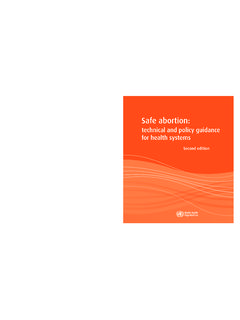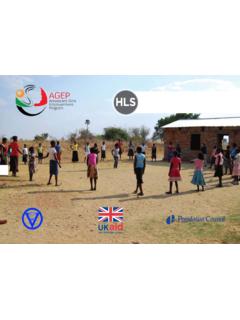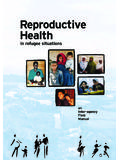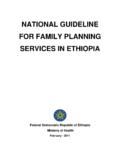Transcription of Introduction - World Health Organization
1 Journal paperJournal paper* This is a pre-print copy of a paper published in the journal The Lancet : David A Grimes, Janie Benson, Susheela Singh, Mariana Romero, Bela Ganatra, Friday E Okonofua, Iqbal H Shah. Unsafe abortion : the preventable pandemic. The Lancet Sexual and Reproductive Health Series, October abortion : the preventable pandemic*David A Grimes, Janie Benson, Susheela Singh, Mariana Romero, Bela Ganatra, Friday E Okonofua, Iqbal H ShahEnding the silent pandemic of unsafe abortion is an urgent public- Health and human-rights imperative. As with other more visible global- Health issues, this scourge threatens women throughout the developing World .
2 Every year, about 19 20 million abortions are done by individuals without the requisite skills, or in environments below minimum medical standards, or both. Nearly all unsafe abortions (97%) are in developing countries. An estimated 68 000 women die as a result, and millions more have complications, many permanent. Important causes of death include haemorrhage, infection, and poisoning. Legalisation of abortion on request is a necessary but insufficient step toward improving women s Health ; in some countries, such as India, where abortion has been legal for decades, access to competent care remains restricted because of other barriers.
3 Access to safe abortion improves women s Health , and vice versa, as documented in Romania during the regime of President Nicolae Ceausescu. The availability of modern contraception can reduce but never eliminate the need for abortion . Direct costs of treating abortion complications burden impoverished Health care systems, and indirect costs also drain struggling economies. The development of manual vacuum aspiration to empty the uterus, and the use of misoprostol, an oxytocic agent, have improved the care of women. Access to safe, legal abortion is a fundamental right of women, irrespective of where they live.
4 The underlying causes of morbidity and mortality from unsafe abortion today are not blood loss and infection but, rather, apathy and disdain toward and Reproductive Health 4 IntroductionUnsafe abortion is a persistent, preventable pandemic. WHO defines unsafe abortion as a procedure for terminating an unintended pregnancy either by individuals without the necessary skills or in an environment that does not conform to minimum medical standards, or Unsafe abortion mainly endangers women in developing countries where abortion is highly restricted by law and countries where, although legally permitted, safe abortion is not easily accessible.
5 In these settings, women faced with an unintended pregnancy often self-induce abortions or obtain clandestine abortions from medical practitioners,2 paramedical workers, or traditional By contrast, legal abortion in industrialised nations has emerged as one of the safest procedures in contemporary medical practice, with minimum morbidity and a negligible risk of As with AIDS, the disparity between the Health of women in developed and developing countries is stark. Unsafe abortion remains one of the most neglected sexual and reproductive Health problems in the World today. This article will describe the scope of the problem of unsafe abortion , estimate its mortality and morbidity, document the relation between laws and women s Health , estimate costs, and describe prevention strategies.
6 The key messages are presented in panel burdenWorldwide estimates for 1995 indicated that about 26 million legal and 20 million illegal abortions took place every Almost all unsafe abortions (97%) are in developing countries, and over half (55%) are in Asia (mostly in south-central Asia; table).6 Reliable data for the prevalence of unsafe abortion are generally scarce, especially in countries where access to abortion is legally restricted. Whether legal or illegal, induced 2abortion is usually stigmatised and frequently censured by political, religious, or other leaders. Hence, under-reporting is routine even in countries where abortion is legally ,8 The use of varying terms, such as induced miscarriage (fausse couche provoqu ),9 menstrual regulation, mini- abortion , and regulation of a delayed or suspended menstruation10 further compounds the problem of producing reliable and comparable estimates of the prevalence of unsafe studies around the World indicate a higher magnitude of unsafe abortion than do Health ,11,12 In Zambia, the extent of maternal mortality from unsafe abortion is not generally known from Health statistics.
7 One study in which women were interviewed revealed that 69% of the respondents knew one or more women who had died from an unsafe illegal Focus-group discussions and community-based studies in India11 revealed self-reported abortions in 28% of women, which is higher than figures derived from national service-delivery show that women in South America, eastern Africa, and western Africa are more likely to have an unsafe abortion than are women in other regions. Unsafe abortion rates per 1000 women aged 15 44 years (figure 1) provide a more comparable measure of unsafe abortion by region. In Asia, south-central and southeastern regions have similar unsafe abortion rates (22 and 21 per 1000 women, respectively), whereas the rate is about half (12 per 1000) in western Asia and negligible in eastern Asia (where abortion is legal on request and easily available).
8 Panel 1: Key messages1. An estimated 19 20 million unsafe abortions take place every year, 97% of these are in developing Despite its frequency, unsafe abortion remains one of the most neglected global public Health An estimated 68 000 women die every year from unsafe abortion , and millions more are injured, many Leading causes of death are haemorrhage, infection, and poisoning from substances used to induce Access to modern contraception can reduce but never eliminate the need for Legalisation of abortion is a necessary but insufficient step toward eliminating unsafe When abortion is made legal, safe.
9 And easily accessible, women s Health rapidly improves. By contrast, women s Health deteriorates when access to safe abortion is made more difficult or Legal abortion in developed countries is one of the safest procedures in contemporary practice, with case-fatality rates less than one death per 100 000 Manual vacuum aspiration (a handheld syringe as a suction source) and medical methods of inducing abortion have reduced Treating complications of unsafe abortion overwhelms impoverished Health -care services and diverts limited resources from other critical Health -care The underlying causes of this global pandemic are apathy and disdain for women.
10 They suffer and die because they are not of unsafe abortions (thousands)Unsafe abortions per 100 livebirthsUnsafe abortions per 1000 women aged 15 44 yearsWorld19 0001414 Developed countries* 500 4 2 Developing countries18 4001516 Africa 4 2001424 Asia*10 5001413 Europe 500 7 3 Latin America and the Caribbean 3 7003229 Northern America N/AN/AN/AOceania* 301217 Source: *Japan, Australia, and New Zealand have been excluded from the regional estimates, but are included in the total for developed countries. N/A=none or negligible : Global and regional estimates of annual incidence of unsafe abortion , 2000 Temporal trends in unsafe abortion have been inconsistent internationally (figure 2).














